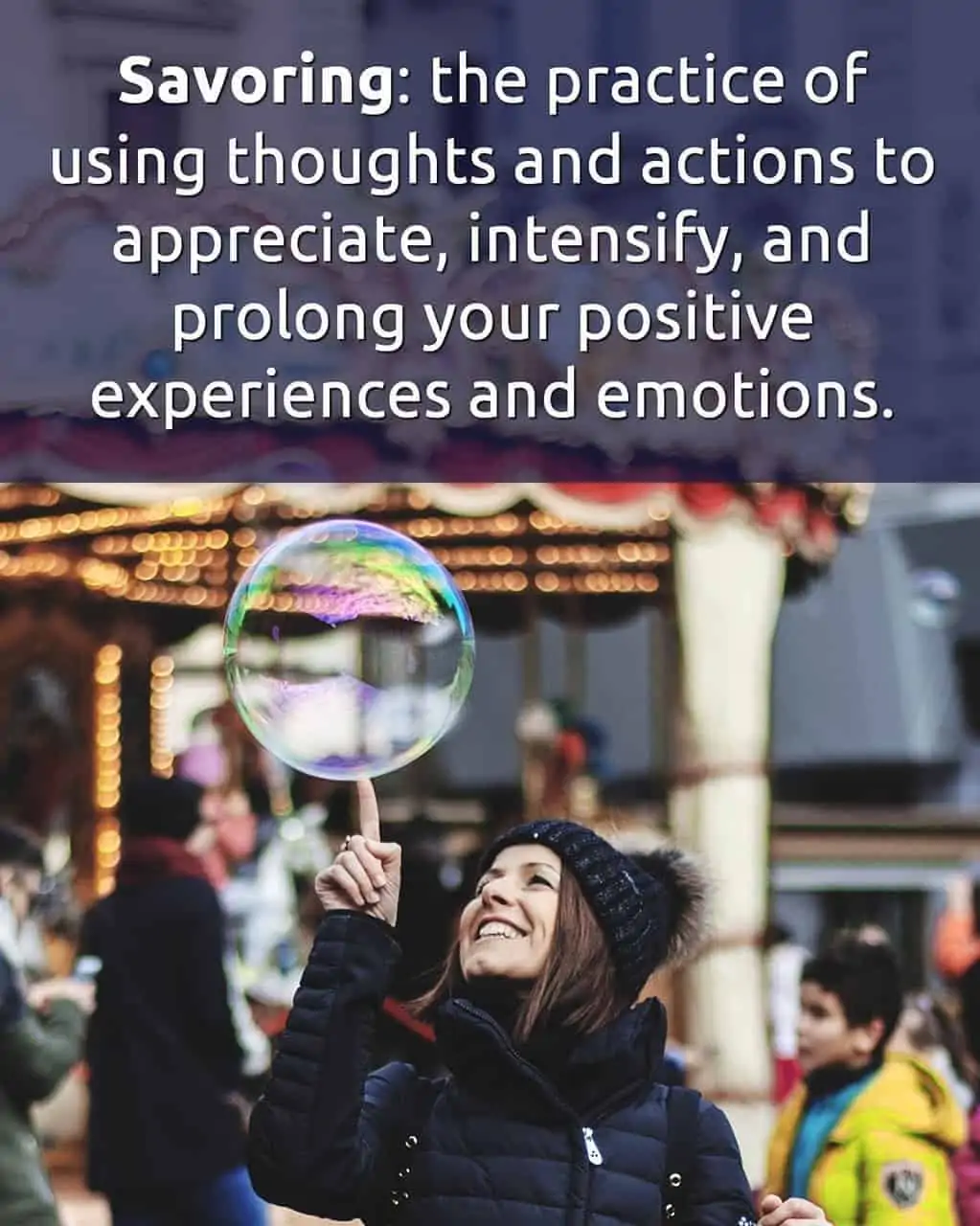Today's Friday • 12 mins read
— By Sunbul Kazmi
Savoring is one of the most underrated ways to make your happiness sustainable.
Imagine you’re at your favorite restaurant, and the waiter brings a beautifully prepared dish to your table. But you don’t dive in. Instead, you look admiringly at the presentation, inhale the tantalizing aroma, and then take the first bite. You slowly let the flavors dance on your taste buds. Your eyes close, as you fully immerse yourself in the taste.
That’s savoring—taking the time to really enjoy and relish the moment. It is a highly effective technique in positive psychology for increasing happiness and well-being. Experts sometimes refer to savoring as an upregulation of positive emotions.
- When that trophy on your mantel becomes a dusty showpiece, savoring can rekindle the joy when you first brought it home.
- A fisherman in a remote village may seem happier with his frugal lifestyle than someone with far more exposure and means.
What Is Savoring In Psychology
Savoring is a well-studied topic in positive psychology.
Savoring means mindfully enjoying and appreciating positive experiences, emotions, or sensations. It involves fully immersing oneself in the present moment to make the experience more enjoyable and prolong the positive feelings.
Savoring can involve various senses and aspects of experience, such as savoring the taste of food, relishing a beautiful sunset, or cherishing a pleasant memory.
Fred B. Bryant and Joseph Veroff in Savoring: A New Model of Positive Experience, define savoring as:
The capacity to attend to, appreciate, and enhance the positive experiences in your life.

Savoring is both gratitude and appreciation.
- Gratitude is being thankful for and acknowledging the good things in life.
- Appreciation is fully experiencing and enjoying those good things.
Savoring is feeling appreciative and thankful for our positive experiences and emotions.
It can boost our well-being and satisfaction, especially when we are actively focused on and fully appreciating those experiences in the present moment.
When you savor, you can say:
- To express appreciation: “I am so grateful for this opportunity to learn and grow, and I truly appreciate all of your support along the way.”
- To express thankfulness: “I just wanted to take a moment to express my heartfelt thanks for everything you do. Your kindness and generosity mean the world to me.”
How Can You Improve Your Savoring
Savoring psychology suggests the following 6 practical tips on how to boost your savoring skills:
1. Cultivating Gratitude
We can apply gratitude to the past (like fetching positive memories and thanking for the good things we received in our childhood), the present (like taking into account and appreciating what you have right now), and the future (maintaining an attitude of hope and optimism).
Regardless of your current level of gratitude, we can cultivate this quality by maintaining gratitude journals, writing thank-you notes, and expressing appreciation verbally.
We could also do it through gift-giving, making lists of our possessions, abilities, and capabilities, opportunities, social connections, even the level of autonomy we may enjoy in our daily tasks and occupation.
The purpose is not to overwhelm you with the sheer number of lists you could possibly make; it is to allow you to slow down, become more aware of what and who you have, how those things and people impact your life, and how these come together to enrich your life.
Offering gratitude adds to increased self-awareness, which allows us to be more mindful of how our inner world interacts with our outer world – thereby allowing us to savor what we have.

2. Body Scan Meditation
Speaking of our inner world interacting with our outer world, another nifty trick in the savoring toolkit is to become fluent in practicing a body scan.
A body scan helps tune into your body’s physical sensations.
The next time you’re having a good time, check in with yourself. Observe the emotions that arouse within, their interplay, as you breathe in, hold, and then slowly exhale.
Notice any sensations you’re feeling, but without judgment. Notice the temperature of the sensation, the movement, and the vibrations.
The goal is to train the mind to be more curious and open to sensory experiences.
Now observe the surrounding stimuli – the mind is a powerful thing, and it stores responses that we have towards different stimuli.
With time and practice, a body scan meditation will sharpen your ability to focus. It will also help you to be fully present in your life – allowing you to not only add depth to your experiences but also replicate and prolong the positive feelings associated with them.
Shamash Alidina, author of the international bestseller Mindfulness For Dummies, says:
“The body scan alternates between a wide and narrow focus of attention; from focusing on your little toe all the way through the entire body. The body scan trains your mind to be able to move from detailed attention to a wider and more spacious awareness from one moment to the next.”
Here’s a 3.5-minute video guide on body scan meditation by Shamash Alidina that even kids can do:
3. Embracing Imagination And Curiosity
If we turn to the experts in the field of imagination – children, of course – we can learn to perform this mental exercise better.
Children are gurus at making sense of the world through beautiful imagery and fancy descriptions. They are also chock-full of curiosity.
So, become curious about yourself, and the trappings of your life. This meaning-making exercise is full of emotion-delight, excitement, and wonderment.
Take, for instance, the furniture in your house. Over time, these objects have simultaneously been the backdrop and the witness to your conversations, moments of joy, sadness, and even solitude.
Do this: Approach with curiosity and creativity as you pick any one object from your furniture, and imagine all the stories it would tell.
The thoughts and memories about the object that evoke the most pleasant emotions are now part of the story of this object. You have created a “key” that you can use any time of the day to re-experience and savor the feelings its story evokes.
Make a query to yourself: Have you become a passionless person in your life, taking your experiences for granted instead of feeling their full effect?
Like a cool glass of water on a hot day, petrichor during monsoons, and the comfort of being your life’s narrator. Look around, breathe in, smile, and exhale.

4. Sharing Your Story
Communicating and celebrating our positive experience with others is a savoring strategy that psychologists call “capitalizing”.
Share the small and the big feel-good moments with others. This helps us bask in the positive warmth of the experience some more.
Research from Shelly Gable, Ph.D., at the University of California, Santa Barbara, found that when they asked others about their good news and listened closely as they recounted their stories, let us be a part of their positive experiences.
Not only does this make it possible for you to reconnect with the past and re-experience the uplifting feelings, but it also helps the people asking questions to feel positive emotions as they help you savor those memories.
The research also found that the act of savoring together regularly strengthens people’s relationships.
5. Ritualizing or Creating Rituals
Merriam-Webster defines ritual as, “a sequence of activities involving gestures, words, actions, or objects, performed in a sequestered place and according to a set sequence”.
In that sense, any series of actions you perform around a task, if repeated regularly, will be called a ritual.
Psychological scientist Kathleen Vohs and her colleagues conducted experiments to examine how ritualistic behaviors might affect our perception and consumption of different foods. They found, when we ritually take part in short and deliberate activities, we seem to savor our experiences more.
Because rituals help us connect with our experiences by drawing us in, this phenomenon is now extended to other activities as well.
When we are immersed in life, actively engaging in the moment we are living, we almost always have a more positive experience.

Take into account all your wins, the big ones and the small ones.
Be self-aware, imaginative, and playful with your rituals.
- You just finished preparing a meal for the family. You could follow it up by making yourself a cup of tea, sitting in your favorite chair, and listening to Mozart.
- There’s an important discussion with your spouse waiting to happen? Why not first dress up, enjoy a long drive, go for some coffee at a quiet café, and then have that talk?
6. Physically Expressing
Another way to prolong and increase positive emotional experiences is to employ actions and behaviors that affirm them. Since the dawn of time, cultures around the world have been using movements and dance as an outward expression of joy and even healing.
Savoring this way can be something as simple as the snap of the fingers, clapping your hands, a hop, or a sequence of movements, or even a dance, which allows your body to express the emotions that arise within.
In one famous study, the experimenters observed that people holding a pen between their teeth while reading a cartoon rated it as funnier.
They concluded this was due to the smile-like expression produced. Physical expressions of positivity – laughing, jumping, and dancing – create extended positive loops of enjoyment.
When we savor, we are having positive feelings and are also aware of them. It’s not only the warmth of being around loved ones, but it’s also the recognition that those connections are very special.
Savoring is a deliberate act of recognizing the value of a moment and retaining the positive emotions that come with it.
Fred Bryant, Ph.D., of Loyola University, who co-authored Savoring: A New Model of Positive Experience with Joseph Veroff, Ph.D., says:
Savoring can help us counteract the natural human tendency to focus more of our attention on negative things in our lives than on positive things.

My Story of Savoring
Ever found yourself gravitating towards a swing set, touching the metal chain, and gingerly settling into the seat? Have you noticed how, with each pump of the legs, your smile has grown wider and wider?
You may have even found yourself reminiscing about your childhood days. A sense of well-being, even giddiness, may have washed all over you.
It was almost like the memories stored in the body got unlocked by a simple contraption in the playground.
Growing up, I’d often see my parents reminisce about their home country. Some stories they furnished with such detail; I could’ve sworn I’d been there. I can’t say for sure how old I was, but during a winter break in Delhi, as my grandfather started our daily ritual of evening tea, I sat back in my chair, with a keen sense of time slipping by.
At that precise moment, I decided to capture this memory, a mental snapshot: the waves in his silver-white hair, the way he smiled indulgently, asking me about my day, prepping and placing rusk in my plate – half butter, half jam. I inventoried the snacks, their texture, the taste of Parle G, and the smell of steaming Bournvita.
I don’t remember the details of our conversation, but the sense of being loved, cared for, and valued is just as keen now as it was some 30-odd years ago.
Without knowing what I was doing, I was savoring our relationship at the moment.
Savoring our relationships is not just feeling the warmth of being around them. It is deeply sensing how special those connections are in our lives.
Savoring = using thoughts and actions to appreciate, intensify, and prolong positive experiences and emotions.
Types of Savoring
- Marveling (awe): It is more than fear or surprise. Find out what is awe.
- Basking (pride): It is when we relish the warm glow of praise or reflect happily on past achievements.
- Thanksgiving (gratitude): It is when we are so thankful that we feel we must express it to the person or the higher power.
- Luxuriating (pleasure): It is the pleasure of our senses, as sipping on some delightful coffee while listening to Mozart’s Serenade No. 13.
Final Words
The year-end holiday season is marked by festivities that show appreciation and thanks in some way.
- Thanksgiving is a day of giving thanks for the blessing of the past year’s harvest.
- Kwanzaa is an African festival that celebrates a successful harvest and gives thanks for good fortune.
- Boxing day is when people around the world give beautifully wrapped boxes containing money, food, clothing, or other gifts, to their employees as a symbol of their gratitude and appreciation.
You don’t have to wait for the next big thing to happen to start a practice of savoring. With conscious effort and attention, you can become better at savoring—immersing yourself ever more deeply in the simple things with immense potential for positive experiences.
Ashley Whillans, an assistant professor at Harvard Business School and a leading scholar in the time and happiness research field, author of Time Smart: How to Reclaim Your Time and Live a Happier Life, says:
Savoring is a form of mindfulness, because it requires you to disconnect from productivity and efficiency and focus on the present. Savoring also requires you to let go of creating the “perfect experience” – people who are maximizers – in favor of creating a good one – people who are satisficers.
However bad your today is, you can always make your tomorrow better and happier. Let these seven strategies help you find a brighter tomorrow.
• • •
Author Bio: Written by Sunbul Kazmi – a Psychotherapist based in Islamabad. Her counseling style is eclectic yet methodical, with a mix of humanistic, psychodynamic, and holistic approaches. She does individual as well as group therapy and her work includes marriage and family counseling, mental health counseling, substance abuse counseling, as well as guidance counseling.
Reviewed/edited by Sandip Roy.
√ If you liked it, please spread the word.